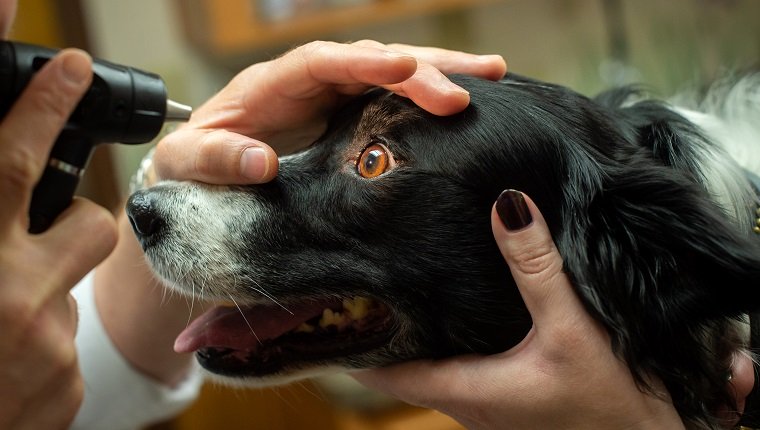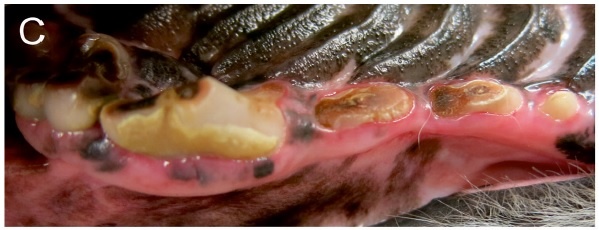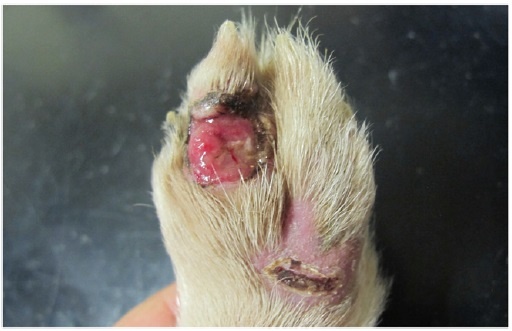
In this article we would like to introduce our new genetic test package for Border Collies. Border Collies have genetic diseases that can lead to serious diseases in their offspring, so genetic testing is a very effective form of prevention. Therefore, certain genetic tests are recommended for breeding dogs, both male and female, prior to planned mating. In the next part of this article you will find a description of the most common genetic diseases in Border Collies, which are included in our package Border Collie XL PANEL | GenoCan.eu
Collie Eye Anomaly (CEA) – The collie eye anomaly originates from abnormalities in the development of eye tissues during the embryonic period. This eye disorder affects the white of the eye, the choroid, the retina, as well as the blood vessels and optic nerve disc. It is manifested by various symptoms such as insufficient blood supply and loss of pigment, insufficient choroidal development, retinal abnormalities or optic nerve bifida. Usually both eyes are affected. Symptoms can vary in severity, combine with each other and may change and worsen over the course of life. The disease can lead to blindness. To diagnose collie eye, an eye examination is usually performed on the puppy in the first 3 months of life, which can be confirmed by a genetic test. The disorder is inherited and is transmitted in an autosomal recessive manner. This means that the affected individual must inherit both mutated copies of the gene from their parents who are carriers of the disease.

Degenerative myelopathy (DM) – This neuromuscular disease causes a gradual loss of muscle mass in the hind limbs and back, which is manifested by poor coordination of movements, constricted and asymmetrical gait, or incontinence. The disease affects a wide range of dog breeds (more than 100 dog breeds have been described) and manifests itself in middle to older age. Unfortunately, the disease is incurable and progressively worsens, with death usually occurring after 3-5 years from the first manifestation of the disease due to general weakness and paralysis of the respiratory muscles.
Multiple drug resistance (MDR1) – Multiple drug resistance is an inherited disease that causes affected dogs to be extremely sensitive to certain drugs (ivermectin, loperamide and many others). Exposure to these classes of drugs can lead to severe neurological symptoms such as hypersalivation, ataxia, blindness, tremors, respiratory problems and sometimes death. The cause of the disease is a mutation in the gene that produces P-glycoprotein, which is responsible for transporting drugs and excreting them. The disease is inherited in an autosomal recessive manner, which means that affected individuals must inherit the mutation on both copies of the gene. However, it is known that even carrier individuals can have a mild adverse reaction after receiving these drugs.
Goniodysgenesis and Glaucoma (GGD) – This disease is characterized by partial or complete closure of a spot in the eye called the iridocorneal angle. Because of this, fluid builds up in the front of the eye and increases intraocular pressure, leading to glaucoma. Glaucoma is a painful disease that damages the layer of tissue on the retina and can cause blindness. The disease is caused by a change (mutation) in the properties of the OLFML3 protein, which causes abnormal cells to form and deposit in the iridocorneal angle. There are two forms of this disease – mild and severe. The severe form is associated with a specific mutation in the OLFML3 protein and the disease is inherited in an autosomal recessive manner.
Intestinal cobalamin malabsorption (IGS) – Border Collies also suffer from a metabolic disorder that affects the body’s ability to absorb cobalamin from food. Cobalamin, also known as vitamin B12, is essential for proper nervous system function, blood formation and DNA synthesis. Its deficiency is problematic for most organs that need regular cell renewal. Cobalamin deficiency is manifested by failure to thrive, non-regenerative anemia, chronic lack of appetite and changes in the bone marrow. The disease is inherited in an autosomal recessive manner.
Neuronal Ceroid Lipofuscinosis (NCL) – Neuronal ceroid lipofuscinosis is a neurodegenerative disease. Affected dogs do not have sufficient activity of a specific enzyme necessary for normal cellular metabolism. As a result, there is an abnormal accumulation of waste substances (ceroid and lipofuscin) primarily in the cells of the nervous system, leading to a number of nervous system disorders. Clinical manifestations appear around the 15-20th month of life. These include behavioural changes, loss of interest in play, hallucinations, disorientation and aggression. Symptoms worsen over time and include ataxia, falls, seizures, abnormal gait, lethargy and loss of vision. Dogs affected by this disease rarely live beyond 32 months. The occurrence of the mutant allele in the Border Collie population is relatively rare. Inheritance is autosomal recessive.
Raine syndrome (RS) – Raine syndrome or dental hypomineralization is a rare disease in the canine kingdom, specific only for Border Collies. The main symptom is widespread dental affection with cracks in the enamel, brown discoloration of the enamel, demineralization of the tooth, osteomalacia and inflammation spreading to the surrounding area, leading to hinge involvement and even tooth loss. The disease is not curable, only in the early stages can the symptoms be alleviated. Inheritance is autosomal recessive.

Trapped Neutrophil Syndrome (TNS) – This disease is characterized by a deficiency of a certain type of white blood cells and an increased amount of certain cells in the bone marrow. Clinically, it is manifested by growth retardation, lack of weight gain and greater susceptibility to long-term infections due to weakened immunity. Young dogs with severe disabilities may have an unusual facial development with a nodular skull, which breeders describe as ferret-like. Some individuals experience the disease in the first few weeks of life, while others show an inadequate response to vaccination at 12 weeks of age. In some cases, symptoms may not appear until two or more years of age in a milder form. The disease is inherited in an autosomal recessive manner.
Sensory neuropathy (SN) – A severe neurological disease manifested by the progressive degeneration of mainly sensory nerve cells. Motor nerve cells are also affected to a lesser extent. The disease is observed in puppies as early as 2-7 months of age. The clinical signs observed include a gradual deterioration of coordination and limited joint mobility. The individual loses the ability to perceive how its muscles and tendons are stretched, misperceives the position of its body and cannot control its movements. In addition, they may also not feel pain, which often leads to more frequent occurrence of injuries (paws, tail, mouth).

Malignant hyperthermia (MH) – The disease is caused by a congenital skeletal muscle disorder where there can be a significant increase in temperature (hyperthermia) up to 45°C, rapid and irregular heartbeat (tachycardia and arrhythmias), rapid breathing, muscle stiffness and can end in renal failure and death. The administration of certain volatile anaesthetics may also be a trigger in genetically predisposed individuals. Inheritance is autosomal dominant.
Early onset hearing loss (EAOD) – This is a genetic disease that manifests itself as hearing impairment or loss in adulthood or old age. Affected individuals most commonly lose their hearing between the ages of 3-5, or later. Hearing loss is gradual, not sudden. We use SNP marker analysis to test for risk, i.e. that the individual may have or transmit EAOD. However, the exact mutation is not known, so the test is less informative and breeders should avoid mating individuals who are both at risk of transmission. Autosomal recessive inheritance is assumed.
Genetic testing is a very important prevention of genetic defects in dog breeds. Testing can significantly reduce the number of puppies born with genetic diseases.




